
Introduced early in 2022, Diemme Filtration’s GHT5000F Domino pressure filter is the
largest of its type in the world, capable of processing up to 12,000 mt/d solids
Filtering the Flow
Mines want to dewater slurries faster, cheaper, more thoroughly and in ever-increasing
volume. Vendors are interested in providing solutions. Here’s a roundup of the latest
developments in pressure filtration technology.
By Russell A. Carter, Contributing Editor

For example, the Reko Diq copper/gold porphy deposit in Pakistan is considered to be the paramount example of its kind since discovery of the Oyu Tolgoi porphry in Mongolia, with historical estimates estimating its resources at 6 billion metric tons (mt) or more of copper content. Progress on development of Reko Diq has been on hold for roughly a decade following a Pakistan court ruling regarding its original licensing process. However, Barrick Gold — which has been involved in the prospect since the early 2000s through Tethyan Copper Co., its joint venture with Antofagasta plc that holds the exploration license — recently announced a framework agreement for development of the deposit that would give it a 50% share and designate it as the operator. The remaining 50% interest would be divided among the provincial government and a consortium of state-owned enterprises. If definitive arrangements with all project shareholders can be completed, the company predicts deal closure during the second half of 2022, to be followed by an update to a 2010 feasibility study during 2023-2024.
Mark Bristow, president and CEO of Barrick Gold, stated in a recent interview, “there’s nothing like this [property] available in the world today,” referring to its potential for supporting a long-lived 80,000-mt/y copper operation that the company intends to develop in two or possibly three phases. And contrary to the old proverb “the devil is in the details,” Bristow doesn’t envisage major problems in the typically complex tasks of arranging financing and building the mine. “[It’s] what we do every day,” when it comes to developing high-tier assets, he explained. “The challenge is about power and water.”
Water is a critical commodity that can be a benefit or a risk — unwanted problems and costs can emerge from either positive or negative water balances, for example — as well as a constant reminder that mines are only one element in a larger environmental and social framework. Without sufficient water, mine production can suffer and expansion plans fade. Take too much, and a mine’s social license to operate can be restricted or revoked, remedial or regulatory problems could spike, and investors may drift away. Now and in the future, mining companies need to vigorously compete against other industrial users and engage with increasing public demands for regulation and allocation of water supplies. With water-related costs mounting and future availability questionable, the industry must evolve strategies that justify its operational requirements and meet its water- related ESG commitments, while staying within tolerable levels of Capex and Opex. In this article, E&MJ looks at some of the dewatering products and technologies that can help in optimizing water recovery from typical plant processes.
Handling More, Knowing More
The toolbox of dewatering aids available
to the industry includes everything from
Al-assisted evaporation data analysis to
zero-discharge water treatment plants,
but traditional solutions such as dewatering
screens, settlers, thickeners, special-
purpose chemical reagents and mechanical
filters are the standard answer
for the need to reclaim process water, and
their role shows no signs of diminishing.
What is emerging, however, is a trend toward
much larger throughput capacities,
particularly in filter presses, and deeper
insight into the actual performance of
dewatering equipment through improved
sensor capabilities, automation and overall
digitalization.
A glimpse of what lies ahead with regard
to filter-press capacities was recently provided
by Diemme Filtration as it introduced
the GHT5000F Domino, a massive 40 x 9 x
7-m unit with throughput capacity of more
than 12,000 metric tons per day (mt/d) of
solids, or approximately three times the capacity
of the largest filter presses currently
in operation. According to Diemme, the
GHT500OF has all of the design features
of its GHT-F model, which in itself was designed
for high throughput/fast filtration
and offered in both 1,500 x 1,500-mm
and 2,500 x 2,500-mm plate sizes. Along
with a plate size of 5,000 x 5,000 mm, the
GHT5000F Domino also offers:
• Remote control, management and optimization
via IIoT;
• An integrated work platform for maintenance;
• Six-point rinsing system for thorough
rinsing of the filter media after each
cycle;
• Automatic high-pressure cloth washing
system with double wash-bar to simultaneously
clean the cloths of two chambers
and halve the downtime for cloth
washing;
• Cloth replacement from either side of
the filter, with simultaneous multi-cloth
replacement capability; and
• Frame parts comprised of factory preassembled
modules to reduce assembly
time at the site, along with quick-connect
cable connections between modules
to minimize wiring and enable
quick assembly.
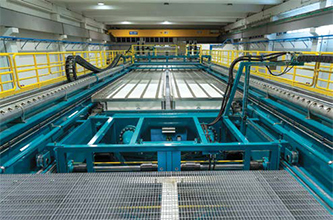
Pezzi said the first GHT5000F was shipped to a location in Peru, where it will filter copper tailings at an estimated rate of 8,000 tons per day solids. Pending performance results from the initial installation, there is a distinct possibility that the first unit could be joined by nine others for total throughput of 80,000 t/d.
FLSmidth’s latest entry in the high-capacity filter press market is the AFP2525, which the company said uses high pressure and low cycle times to achieve significantly larger single-machine capacities. Capable of recovering more than 200 m3 of water per hour, the filter is specifically designed to optimize large-scale filtered tailings dewatering. This, according to Kenneth Rahal, director-tailings solutions at FLSmidth, means that for a typical mine running at a rate of more than 21,000 mt/d, a filter installation will recover enough process water to fill six Olympic swimming pools every 24 hours. With water reclamation rated at up to 95%, freshwater intake is slashed and a tailings storage site can be sized less than 50% of a conventional facility. This also results in a reduction in closure costs at end of mine life and allows for progressive closure, while the site has greater potential to be restored and revegetated.
FLSmidth is also working on an even larger filter press model, the MD5030, that would offer a 5 x 3-m plate size, aimed at improving the economics of filtration for large throughput mines. The company demonstrated a single-cell prototype to interested parties in 2019, and estimated that the ultimate dimensions of a commercial-scale 5-m x 3-m filter press with 160 plates would measure 47 m long by 9 m wide and 8.5 m high, with total mass of 1,100 mt. The filter’s “follower” rail drive alone would weigh more than 150 mt — about the same as a GE 4500 railroad locomotive. The company said it is currently working with multiple customers that are investigating filtered tailings through pilot studies and PFS studies, and whose output is appropriate for the MD5030’s capacity.
Another recent introduction is Andritz’s ME2500, which the company said represents a best-fit value proposition for fast processing of concentrates and typical or high clay-content tailings. The ME2500, available in plate sizes from 1,500 mm to 2,500 mm, offers capacity of up to 450 kg/m2 per hour, filtration area of up to 840 m2 and chained plates for fast filter cake discharge. Its innovative closure system, according to the company, largely uses electrical components rather than hydraulics, which improves safety through more precise control and less reliance on high-pressure lines that are susceptible to leaks.
Andritz pointed out that operations running either single units or multiple filter presses can benefit from “intelligent” filter press operation through its Metris addIQ digital control system, which is available in various package configurations based on the type of machine it is used with and can be augmented with optional add-ons.
Identifying the Right Option
Before a mine jumps to the conclusion
that only one type or size of dewatering
equipment is the answer to its process dewatering needs, it’s important to take
a look at the bigger picture, according to
industry experts.
Kenneth Rahal explained that “As every site is unique, it is important to find the solution that best meets their needs. In terms of dewatering, there are multiple options that achieve different water recoveries at different cost levels. The selection of the most appropriate solution is often based on the water balance requirements that ensure sufficient water is recycled for ore processing. The different dewatering solutions can reduce the fresh water needed for processing from 0.5-0.7 m2 fresh water per ton of ore used in traditional wet impoundments down to as low as 0.15-0.2 m3 for filtered tailings.
“Even within filtered tailings, there are options which can impact the cost of the solution, such as the use of vacuum filters instead of pressure filters,” Rahal said. “The exact filtration technology used is dependent upon a range of factors including the particle size distribution of the tailings and the moisture target.” Co-mingling filtered tailings with waste rock, an approach that FLS has demonstrated with its EcoTails approach, can provide benefits such as additional geotechnical stability to the stack and reducing land usage requirements and cost versus filtration only, Rahal noted.
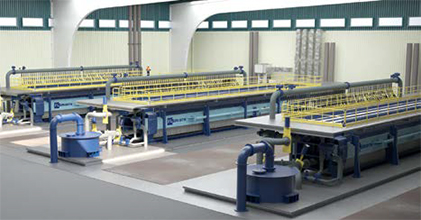
“Good tailings management fundamentally requires a holistic approach to water management throughout the process flowsheet. That means looking at methods, technological solutions and digital optimization opportunities throughout the entire mineral processing flowsheet to find ways to reduce freshwater use, which in turn will reduce the amount of water that needs to be managed in tailings. This holistic approach to solutions, underpinned by digital/ data optimization, is the future of tailings management,” according to Rahal.
Job Kruyswijk, manager-integrated slurry solutions at Weir Minerals, cautioned that the strong focus on filtration means that conventional dewatering techniques are often overlooked. “In existing operations, reviewing the dewatering circuit often leads to the identification of several ways in which significant improvements can be realized without having to revise the entire system. For example, the addition of the latest generation of Cavex hydrocyclones or an upgrade of the thickener feedwell, may improve operations markedly,” Kruyswijk said, adding that, “Utilizing conventional technologies in innovative ways can have immediate effects on the sustainability performance, and reduces operational costs. Tailings dewatering and pumping shouldn’t be thought of as two distinct systems. In many instances, improving tailings dewatering allows for more energy efficient pumping.”
Choices Beyond Filtration
Comminution equipment choices can
have a direct effect on water usage and
recovery. For example, FLSmidth’s Rahal
pointed out that HPGRs for primary grinding
can minimize environmental impacts
that normally occur in the grinding circuit
by replacing traditional SAG and ball
mills and associated grinding media. HPGRs
are dry grinding machines and when
configured with air classification, deliver
a 100% water-free comminution circuit.
Additionally, the technology reduces the
amount of fines generated, which improves
the dewatering rates of tailings.
“We are [also] working on coarse flotation as a priority area,” he added. “Coarse particle flotation technologies have the benefit of reduced grind requirements, while allowing for fast-filtered tailings. One of our collaborative projects is the REFLUX Flotation Cell (RFC), which has excellent potential for reducing energy and water use. RFC has a higher throughput and improved separation efficiency compared to traditional methods, reducing the amount of water needed.”
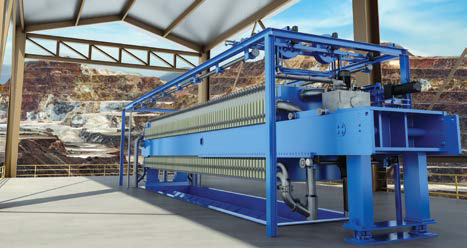
Depending on lab results, filtration machines or thickeners may be identified as best solutions for a dewatering problem, or a combination of both. A thickener, by itself, can provide immediate water recovery improvements, according to the company. In a mass-balance comparison study featuring a typical effluent stream from a plant, for example, adding a thickener that produces solids concentration of 35% solids by weight can generate a clarified water output of 1,588 m3/h. This represents an immediate water recovery of more than 88%. And, if the thickener and process water tank are located near the plant, the energy needed to return water from a distant pond is reduced.
Thickeners are offered in many different designs, and the correct configuration for a specific plant largely depends on operational goals for handling the underflow slurry. McLanahan said the most common thickener style in the mining industry is the high-rate thickener — not only because it is the least expensive from a capital standpoint, but it will often produce an underflow that is easily handled with conventional centrifugal slurry pumps. High-density thickeners are an option if a mine is planning on dry stacking fine waste by processing the sludge through a filter press or similar device. Paste thickeners are utilized to gain maximum water removal by sedimentation methods alone. These units are designed to produce, as the name suggests, a paste — defined as a slurry in which there is no further separation of free water from the slurry.
Noting that recent improvements in recessed plate filter presses have resulted in consistently drier filter cakes, the company spokesman said in the mass balance example previously cited, a filter press could likely boost sludge solids concentration from 35% to 75%-85% solids by weight, along with a 98% recovery of process water.
The McLanahan spokesman also pointed out that it’s important when dewatering a final product to ensure that valuable product is not removed with the water. Depending on final disposition of the material, different types of dewatering equipment can fit the bill. If the product is required to sit in place for a period of time, a separator and a drainage field will suffice. If it must be conveyed, a fine material screw washer or dewatering screen will provide the necessary reduction in moisture content.
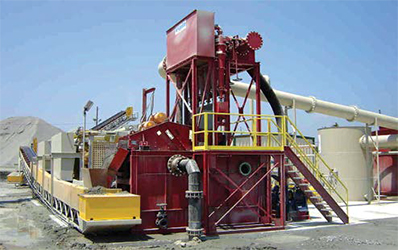
Almost 20 years ago, McLanahan’s Linatex Process Technology Group came up with the idea of combining cyclones with the company’s dewatering screen to provide a solution. The cyclones recover solids, and the dewatering screen, with its attendant low open area and caking abilities, traps ultra-fines in its oversize. The systems are robust as they include only familiar, proven equipment and are easily deployable as modular systems that can be erected by straightforward crane lifts.
Weir Minerals’ Job Kruyswijk said sustainable tailings management means finding the right balance between tailings storage facility stability, water conservation, energy consumption and CO2 emissions. It’s generally true that drier tailings are more stable, he noted; however, dewatering tailings is energy intensive and that intensity increases relative to the level of filtration required. In applications where long-term dryness of the tailings cannot be guaranteed due to climatologic or operational conditions, “over” dewatering tailings causes unnecessary CO2 emissions. Sustainable tailings management is, therefore, an exercise in identifying and realizing the optimum solution for each specific project.
“We work with our customers to find the right balance between dry and sustainable tailings; on many projects, we’re finding this often has us opting for a high density paste system,” said Kruyswijk. “These systems offer a reliable and durable solution and are generally less expensive than filtered tailings solutions. Another major benefit of a paste system is that it provides a greater level of predictability around operating costs. Because it utilizes less water and energy, it’s less prone to price fluctuations and other regulatory measures, like carbon taxes.”
Weir Minerals and Andritz, after working together on several tailings projects in recent years, signed an agreement during the MINExpo 2021 trade show to expand the arrangement, providing an opportunity for potential future collaboration on technology combining Andritz’s separation expertise with Weir Minerals’ minerals and tailings processing technology. Kruyswijk said, “With Andritz’s portfolio of dewatering products and technologies and Weir Minerals’ pumping knowhow and capabilities, we can deliver bespoke tailings handling systems that are both sustainable and cost effective.”
Other Avenues to
Effectiveness
Mechanical solutions aren’t always the
complete answer to treatment of process
slurries, particularly when filtration
involves complex ores, greater throughput
requirements and higher fines and
ultra-fines content in tailings. Improvements
in chemical dewatering aids and
even filter cloth durability can contribute
to lowering operational and maintenance
costs, while advances in data collection
and analysis can give operators the means to make better decisions and quicker adjustments
for overall better performance.
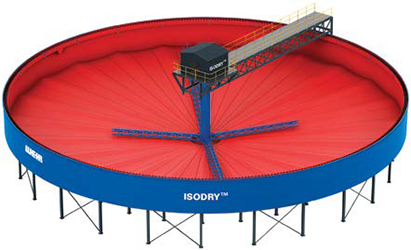
In addition to filtration of concentrates and tailings, Clariant recognizes that mine operators are also focusing on recycling process water that brings additional challenges regarding water quality. For gold producers, removing cyanide from process water is imperative. In a recent example, a gold producer was experiencing clogged filters and was struggling to achieve the required cyanide levels in the process water, and Clariant FLOTICOR additives enabled the customer to achieve the desired water quality.
Micronics Engineered Filtration Group
introduced MINE-XLL in 2020, a new
filter cloth product claimed to provide
superior service life, thus reducing the
frequency of filter cloth change-outs. According
to the company, typical mining filter
cloths last approximately 1,500-3,000
cycles in mineral processing applications
but Micronics said the new heavy nylon
filter cloth can regularly offer a threefold
improvement over traditional polypropylene
(PP) felted mining cloths, including
its own. Citing reports from sites involved
in site evaluations of the new filter cloth,
Micronics said some customers were
reaching 10,000 cycles before needing a
cloth change-out.
Other benefits attributed to MINE-XLL
include:
• Better cake release than traditional
polypropylene felted mining cloth;
• Greater mechanical resistance to highly-
abrasive, high velocity mine slurries;
• Less fabric blinding – cloths stay cleaner
with less washing needed;
• Lower cake moistures, resulting in lower
hauling costs; and
• More machine up-time.
FLSmidth introduced its Maxa plate, which, among other benefits, is aimed at preventing premature cloth and plate failure by use of optimized transitions and geometries. It also increases the filtration area and volume for increased throughput. Features offered by the new plate design include modified interfaces between the plate and cloth for greater support, thus minimizing high stress areas on the filter cloth, and engineered port locations and size to promote filtrate flow. Air for cake blow also is introduced at a lower velocity to reduce abrasion.
Doing More With Data
Although a quick glance at pressure
filtration seems to indicate a simple
operation — fill, squeeze, blow, shake
and wash — it’s actually a much more
complex process that can be difficult to
model precisely for quick adjustment
and optimization, particularly if parameters
such as how much pressure was
applied, how much water and slurry were
involved, and how much air was used
in drying aren’t immediately available
— and if they are, how accurately the
data can be interpreted. Real-time data
collection and analytics technology can
lend a helping hand in solving the problem,
according to recent developments.

Roxia, a Finland-based supplier of dewatering, environmental technologies and industrial automation solutions, offers Malibu, an IIoT-based digital filtration monitoring system that enables users to: • Discover problems in drying by following abnormalities in air pressure curves. • Detect cloth and membrane damages at an early stage by analyzing water volume changes. • Ensure product quality by analyzing cake moisture or filtrate opacity and conductivity. • Identify indications of cloth damage and clogged grids and eliminate production shortfalls, high moisture content and deformed filter plates.
Andritz’s control system, Metris addIQ, is available in different packages according to customer needs. The packages include Metris addIQ Dynamic, Metris addIQ Prime, and Metris addIQ Flex, depending on what level of control, analysis and customization is desired. As explained in a paper* presented at a recent filtration technical conference, Andritz now can provide customers with a tool that indicates when a filter press will need to be cleaned and its filter cloths changed. Using real-time process parameters monitored by an instrument called the Lenser I-Plate, Andritz said it can help mines can save time and energy as well as avoid unnecessary mechanical strain on the plates and cloths by knowing the optimum point at which to terminate filtration cycles.
The I-Plate, developed by Lenser, a German company that has supplied filter elements since 1969, comprises a sensor mounted on a filter plate that allows a view into the filter chamber while the press is in operation. The integrated sensor records the filtration process based on humidity, temperature and electrical conductivity in the filter cake and makes it available visually, enabling real-time monitoring, evaluation of digital data and detailed time and cost analyses. For example, use of the data provided by the I-Plate allows identification of the ideal shut-off point of the filling process for different suspension qualities, or to pinpoint the optimum end of the filtration cycle at an early stage during the post-pressing process, according to Lenser’s technical literature.
Throughout the entire dewatering process, a combination of equipment sensors, instrumentation and automated control systems can enhance the dewatering process, FLSmidth’s Rahal explained. These solutions range from flocculant dosing in thickeners to condition monitoring of pumps, thickener rakes and filter presses. Other digital solutions include equipment controls, advanced sensors and GPS tracking of stacking systems. 3D tailings terrain models will provide miners with a full overview of moisture content for individual areas including offering recommendations of placement support planning and risk management.
Rahal said the company believes digitalization can have significant benefits for dewatering and has developed Smart Tailings offerings for thickeners and filtration. Smart thickening improves the controls around the thickener to increase underflow density and improves stability to result in optimized flocculant consumption, which is the primary Opex driver for thickening. “Smart filtration optimizes filtration throughput and results by the real-time trending of data including feed characteristics, and real-time cake moisture obtained using a proprietary moisture sensor. This information allows filters to adapt to and automatically adjust filter parameters and setpoints to achieve optimal results with fluctuating feed characteristics,” he explained.